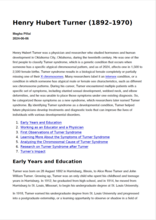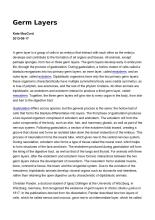Filter my results


Torsten Nils Wiesel studied visual information processing and development in the US during the twentieth century. He performed multiple experiments…
VisionVisual pathwaysNobel Prize winnersNeural networks (Neurobiology)Neural Receptors
Henry Hubert Turner was a physician and researcher who studied hormones and human development in Oklahoma City, Oklahoma, during the twentieth…
Turner SyndromeNoonan SyndromeKlippel-Feil SyndromeEndocrine System DiseasesEndocrine Glands
Gertrude Belle Elion was a twentieth-century scientist in the US who researched the structure of viral DNA to help develop anti-viral medications.…
AcyclovirHerpesvirus 1, HumanHerpesvirus 2, HumanDNA, ViralHIV (Viruses)
A germ layer is a group of cells in an embryo that interact with each other as the embryo develops and contribute to the formation of all organs and…
GastrulationEmbryologyCell differentiationEmbryosCells
Among other functions, the Notch signaling pathway contributes to the development of somites in animals. It involves a cell signaling mechanism with…
Notch genesNotch ProteinsReceptors, NotchNotch Receptors
Bacteria of the genus Wolbachia are bacteria that live within the cells of their hosts. They infect a wide range of arthropods (insects, arachnids…
WolbachiaBacteriaHost-bacteria relationshipsHost-parasite relationshipsArthropods
Michael R. Harrison worked as a pediatric surgeon in the US throughout the late-twentieth century and performed many fetal surgeries, including one…
Birth DefectsAbnormalities, HumanPediatric surgeonsMyelomeningoceleSpinal Dysraphism
Turtle morphology is unlike that of any other vertebrate. The uniqueness of the turtle's bodyplan is attributed to the manner in which the turtle's…
TurtlesEvolutionMorphology
The term morphogenesis generally refers to the processes by which order is created in the developing organism. This order is achieved as…
Morphogenesisdifferentiation
Purkinje cells, also called Purkinje neurons, are neurons in vertebrate animals located in the cerebellar cortex of the brain. Purkinje cell bodies…
Purkinje CellsCerebellar CortexcerebellumBrain Stem